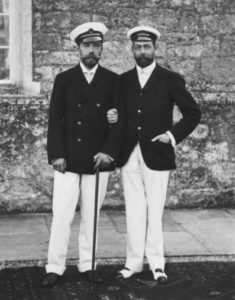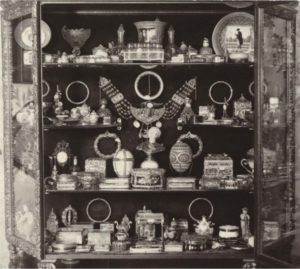The King’s knowledge and clear enjoyment of Fabergé’s
work encouraged many of his friends and contemporaries
to become clients of Fabergé. These included some of the best
customers of the London branch, such as Stanislas PoklewskiKoziell, a councillor at the Russian Embassy in London, Leopold
de Rothschild, Sir Ernest Cassel, Lord Revelstoke, the Duke
of Norfolk and the Marquis de Soveral. The London ledgers
are full of the names of royalty and aristocrats from every corner of Europe and the Indian sub-continent. While many
of Queen Alexandra’s Fabergé objects were intended to
charm and delight and were arranged in her cabinets at her
whim, the more practical items acquired by the King were
regularly used. They sometimes required repair, and there
are several entries in the London ledgers for re-enamelling
cigarette cases owned by King Edward VII and later by
King George Y
Princess Victoria (1868-1935), the second daughter of King Edward VII and Queen Alexandra, inherited
her parents’ interest in Fabergé. She was a good customer
of the London branch and purchased many pieces both for
her own collection and as gifts. She often accompanied Queen
Alexandra on visits to the London branch, where they would
enjoy examining pieces newly arrived from Russia in what was
in effect their private showroom. Her own small collection
was principally of animals and flowers, but she purchased a
range of objects including several pieces of jewellery, such
as tie-pins, pendants and brooches. She also bought cigarette
cases and an unusual frame with miniature views of St Petersburg (cat. 229). Princess Victoria inherited several pieces from
her mother, such as parasol handles, flowers and animals.
As she did not marry, these were bequeathed to King George
V after her death.
Possibly an even greater admirer of Fabergé than his
sister, King George V acquired many pieces both as Prince of
Wales and later as King. He was particularly enamoured of the
animal sculptures and bought many of those originally commissioned by his father in 1907. Several of the portrait sculptures
from Sandringham were of dogs owned by him and kept at
the kennels there, such as the Clumber spaniel Sandringham Lucy (cat. 20). He describes in his diary numerous visits

George V), at barton Manor, Isle of Wight, August 1909.
to Fabergé’s London branch. On 3 May 1903 he reports some
early purchases, either at the branch or on a visit by Fabergé
to Marlborough House: ‘he [Fabergé] has just come over from
Russia, we bought about 43 of his lovely things.’16
As Duke
of York, he had visited Fabergé’s St Petersburg headquarters with his father in 1894 while attending the funeral of Tsar
Alexander lit and the marriage of Tsar Nicholas II and Princess Alix of Hesse. During this time he also visited the Baron Stieglitz
School in St Petersburg where many of Fabergé’s designers
and craftsmen were trained. King George V describes with
great affection the occasions on which he met his
Russian cousin, notably at Cowes in August 1909 when the
imperial family arrived aboard their yachts the Standart and
the Pole Star. He recalls that he had not seen the Tsar and
Tsarina for twelve years. Nine years later, in July 1918, after
the brutal murder of the Tsar and his family, the King wrote
in his diary, ‘I was devoted to Nicky, who was the kindest of
men, a thorough gentleman, loved his Country & his people.’17
Just as happened among his parents’ generation, gifts were
exchanged on occasions such as the meeting at Cowes. There
are letters from the King to the Tsar, held in the Russian State
Archive which record the King’s thanks for gifts at Christmas
in 1906,1908-10 and 1912. The gifts described include a stick
handle, some vases, a match box, a cigarette case and a
bust of the Tsar. At least some of these would have been
supplied by Fabergé.18
In addition to the animal sculptures which King
George V particularly liked, he also added to the collection
desk accessories, cigarette cases and frames. He used such
items as the desk clock (cat. 276) and the pen rest (cat.
285) at Buckingham Palace.19
His most notable acquisitions were, however, made long after the London branch had closed. In the 1930s, together with Queen Mary, he bought
the three Imperial Easter Eggs now in the Royal Collection.
They both continued buying works by Faberge from a number of different sources after 1917, including the dealer Wartski
and Goode’s Cameo Corner. The firm of Wartski had been
established in London from 1911 by Emanuel Snowman, one
of the first Western dealers to bring works by Faberge out
of Russia after the Revolution. Queen Mary acquired numerous pieces from the firm, notably the Easter egg made for the
Kelch family (cat. 4).
Queen Mary acquired a large number of pieces
for the collection, mainly in the form of cigarette cases and
snuff boxes given to King George V who owned many such
objects. She also received many gifts from the imperial family,
such as the nephrite box given to her in 1912 by the Dowager
Tsarina Marie Feodorovna (cat. 150), and from her friends,
many of whom were noted Faberge collectors. Two examples are the bonbonniere with views of Balmoral Castle and
Windsor Castle which was given to her for her birthday in 1934
by Sir Philip Sassoon and the imperial presentation box given
by the Maharaja of Bikanir for her birthday in 1937 (cat.
177 and 142).

Faberge collection in a
display cabinet at
Buckingham Palace, c.1950.
Pieces purchased by Queen Mary from the London
branch included miniature eggs, animals, bell pushes and flowers, but it seems the majority were intended as gifts, as
many of them no longer survive in the collection. As a renowned
collector of objets d’art of all kinds, Queen Mary kept fastidious records of all the pieces she acquired for the Royal
Collection, which were listed by year of acquisition and by
type of object, and for each of her acquisitions she made a
record of the provenance of the piece as given to her.20
Her
taste ranged from eighteenth-century gold snuffboxes to lacquer and jade, but she had a particular fondness for Faberge.
In many respects she may be regarded as the first serious collector of his work in the British royal family. It was not without
reason that Bainbridge described Queen Mary in 1949 as ‘the
greatest surviving connoisseur of Faberge’s craftsmanship’,21
and among King George V’s papers in the Royal Archives is a
list of all the Faberge workmasters annotated in her hand, noting how useful the document was.22
Queen Mary was instrumental in influencing a whole
generation of collectors who sought to acquire pieces with
imperial provenance. Her own most notable acquisitions were
the three Imperial Easter Eggs purchased with King George V
in the 1930s, but in addition to her collecting, she stimulated interest in the subject of Faberge by attending sale views
and exhibitions and paying regular visits to West End dealers.
She twice visited the Russian exhibition held in Belgrave Square in 1935, on 30 May and again on 14 June, when she recorded:
Vent to the Russian Exn. again at 7 (when the public had left).
Met by Mr C. Faberge’s son & Mr Bainbridge. Looked at the
china, silver, & the Faberge things, most interesting’.23
Sir
Owen Morshead, the Librarian at Windsor Castle, went to
the same exhibition and wrote to Queen Mary on 4 June,
encouraging her to attend the exhibition and to meet, through
Lord Herbert, Faberge’s son.24
Connoisseur magazine gave
a lively review of the exhibition, which had been opened by
the Duchess of Kent and to which Queen Mary had made
several loans.25
On 31 January 1949 Queen Mary visited
Sotheby’s to view ‘some Faberge things and very pretty trinkets’26
which had belonged to Sir Bernard Eckstein, the noted
collector and Faberge enthusiast. One of the objects sold at
the series of six Eckstein Collection sales was the Imperial
Easter Egg known as the Winter Egg, which sold in New %rk
in 2002 for $9.5 million. In 1949 it had realised £1,700. Another
of the pieces included in the same sale was the convolvulus
plant, now in the Royal Collection (cat. 123), which was given
to Queen Mary by the royal family on her birthday in May
1949.27